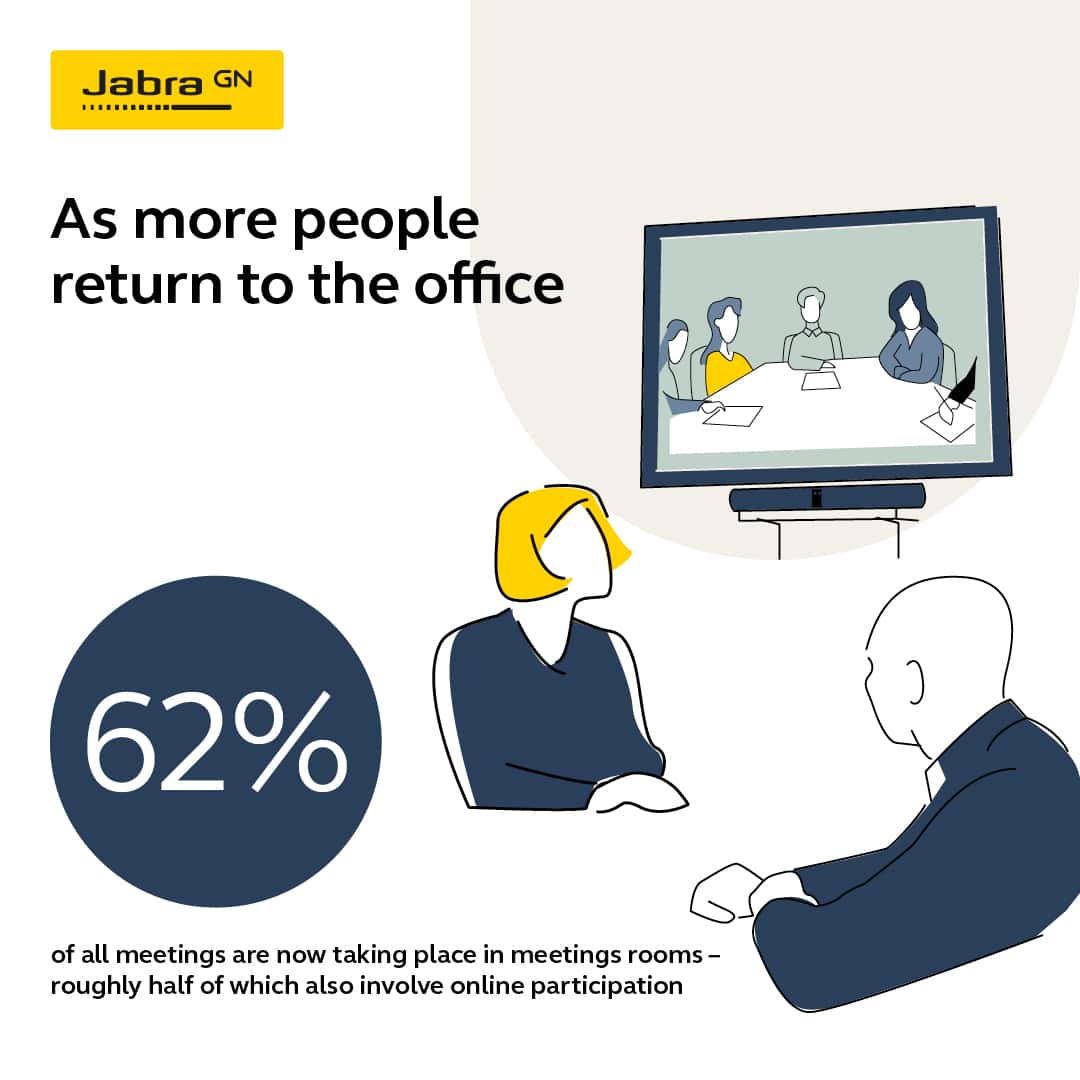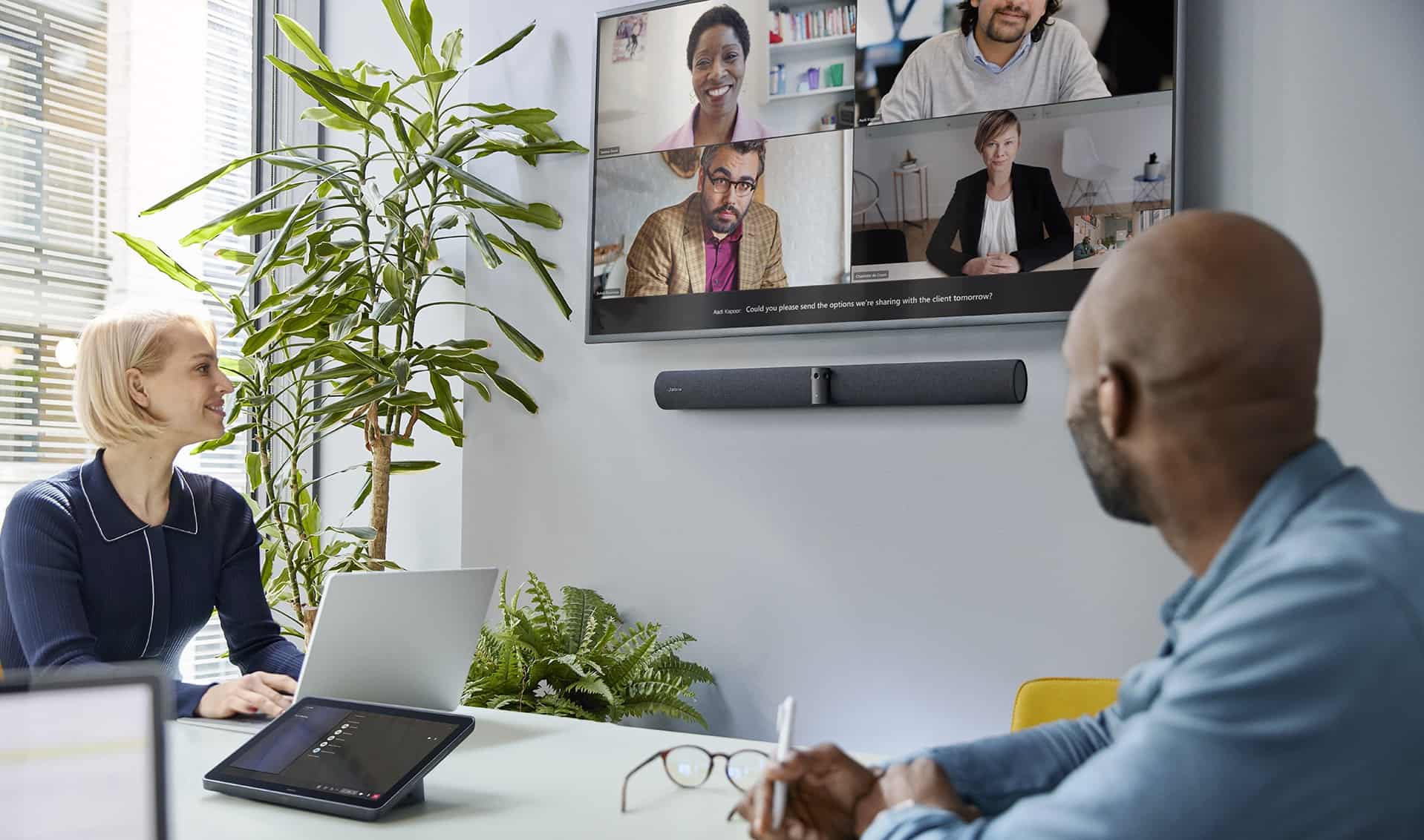In March 2020 the COVID-19 pandemic changed the way we worked overnight. As companies closed their office doors and sent employees home with hastily located laptops, remote working became a normality for over 17.4% of the global population1. Fast forward to 2023, and with COVID-19 no longer designated as an emergency and individuals seeking the benefits of collaboration, employees are returning to their places of work in increasing numbers.
This return to work has led to a resurgence in the use of meeting rooms, but with this comes a number of challenges that organisations will need to overcome if they want these meetings to be inclusive, inspire innovation and increase productivity.
What constitutes a meeting and how has it changed?

The traditional meeting conjures up images of people sitting around the boardroom table, taking it in turns to speak about an agreed agenda and whilst the places and faces are ever changing, this meeting structure remained largely unchanged until 2020. As workforces became hugely dispersed following the outbreak of COVID-19, the traditional structured meeting at a pre-agreed time was suddenly turned on its head. Chats by the water cooler and quick catch ups over a coffee in the workplace kitchen were no longer possible and were quickly replaced by 15-minute video calls, effectively changing every communication into a ‘meeting’.
As more employees return to the office, less time is actually being spent in meetings, but are these meetings more meaningful and productive? As the casual catch ups and morning debriefs can now take place in the office itself, it could be argued that meetings are being reserved for more structured tasks.
One thing we do know for certain, is that the return to the office is sparking an increased reliance on meeting rooms. According to the Jabra Hybrid Ways of Working 2023 Global Report, 62% of all meetings now take place in a meeting room. As companies shift towards full time office or hybrid working models, collaboration is being led from the meeting room, but interestingly half of all meetings that take place in a meeting room have online participants. The need for meeting rooms that are equipped with the right technology to ensure all participants can be included equally is therefore more important than ever before.
Hybrid working and meetings: what are the challenges?
The Jabra Hybrid Ways of Working 2023 Global Report highlights 3 key challenges to hybrid working meetings: inclusion, professionalism and meeting room technology. By being more aware of these challenges, organisations can seek to create meetings that make all participants feel included and able to contribute.
A good meeting is one that everyone feels included in. Whether the organisation is following a full-time office or hybrid working model, it’s important to make all participants feel equally included so they feel able to share their ideas and contribute to the discussion. The biggest challenge in doing this is that not everyone communicates well in the same way. Whereas some individuals prefer a face-to-face scenario where they start to build rapport from the initial handshake, others feel more protected in a video call where they can sit comfortably at their own desk. Organisations will need to take these different preferences into account and ensure that everyone can join the meeting from wherever they need to, or prefer to be.
A good meeting is also one in which all participants are engaged. The challenge arises with the camera itself and whether to have it switched on or off. Having video enabled means participants can get a better understanding of each other through facial expressions and body language, but it can also be off putting to those who are conscious of how they appear and behave whilst watching themselves on screen.
The third factor that makes a good meeting is the right meeting room technology. The Hybrid Ways of Working 2023 Global Report by Jabra found that only 1 in 10 meeting rooms are equipped with video technology and even if they are, not everyone knows how to use it. As a leading systems integrator we work with a variety of the top vendors to deploy meeting room technology when and where businesses need it most, so we are fully versed in the challenges organisations face when it comes to finding and integrating the best video conferencing solutions. We know firsthand that many physical meeting rooms are not equipped with the right video technology to enable online meetings with those who are working remotely or in different locations worldwide. As the return to office intensifies, with 64% of leaders globally predicting a full return to in-office working by 20262, the need to connect meeting participants quickly, easily and effectively should be a top priority.
How age impacts the meeting experience
The challenges to facilitating a good meeting are compounded by the fact they differ according to the age of the participants. As the Jabra Hybrid Ways of Working 2023 Global Report reveals, Gen Z and Millennials are 2-3 times more likely to say they feel left out in an online meeting. They also feel more pressure in video meetings and are more likely to experience stage fright when speaking, than Gen X and Boomers. Perhaps this is a reflection of their youth and inexperience rather than a difficulty in mastering the techniques and technology, as they are, after all, the individuals who have grown up in the digital age.
Why cultural differences matter
It isn’t only the age of participants that can create new challenges in a hybrid working meeting scenario. Global companies and those who need to hold meetings with participants in other countries will need to take cultural differences into account when developing the most effective meeting room setup. For example, whilst Japanese employees may prefer to take meetings in a meeting room using a video system or their own laptop, their European counterparts are quite comfortable taking meetings at their desk in an open office environment. By being aware of the differences that may be presented in a global video meeting, organisations can work to overcome the barriers to effective communication.
Signs your current meeting room setup isn’t working
If the challenges businesses face when facilitating meetings in a hybrid working environment sound all too familiar, then it might be time to review your approach to meeting room technology. Here are some of the key signs that your current meeting room setup isn’t working:
- Meetings are being dominated by one or two voices.
- Creativity and engagement are low.
- Technology and AV issues cause delays and break up the flow of creativity.
- There is low trust amongst participants, particularly if some participants enable video and others don’t.
Hybrid working and meetings: how to make them work
From what we have learned from the Hybrid Ways of Working report and our own experience, here are some recommendations to make meetings more effective in a hybrid working model:
- Make sure that everyone who needs to be in the meeting can express themselves, whether it is in-person or on video. Remember that remote and hybrid workers make their connections digitally and can’t rely on the tone and feel of the room, so it’s vital they have access to high quality video and audio to feel included.
- Don’t judge those people who have their video off as they may feel pressured. Allow everyone to join the meeting in a way that works for them.
- Don’t allow bad technology to hold people back.
- Make meeting rooms (particularly small/huddle spaces) more readily available for those who prefer to connect from within that meeting room environment.
- Create the right layout – ensure everyone can see, hear and be seen and heard.
- Don’t assume everyone will know how to use the technology – provide training for using AV equipment in meeting rooms, create guidelines for meeting scenarios to make it less stressful across the generations and consider getting high collaborators with lots of experience to offer guidance and training to low collaborators.
The return to office movement might be in full swing, but it hasn’t changed the fact that many meetings remain online. If anything, the increase in full-time office and hybrid working has made structured and meaningful meetings even more important. With business leaders and employees returning to the office for the very reason of better collaboration, it is extremely pertinent to create meeting rooms and deploy technology that allows all participants to feel equally included. Enabling participants to feel they are part of something can improve their wellbeing, performance and commitment to the organisation, so it pays to be aware of the ways meetings are changing and how to overcome the challenges hybrid working presents to effective collaboration.
If your business is looking for meeting room technology to facilitate better meetings, get in touch with AVI-SPL today. As an experienced digital workplace services provider we’ll find the best option that fits your needs and enables better team collaboration, no matter where your teams are.
Additional Sources:

